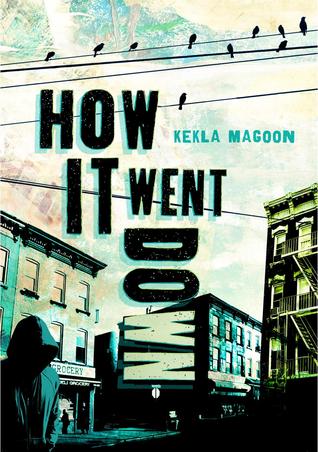
Review for “How it Went Down” by Kekla Magoon (2014)
Rating: 2 out of 5 stars
One of the struggles I remember having as a middle school teacher was finding books about current issues that are timely and relevant to urban youth. In 2012, I was teaching 8th grade when Trayvon Martin was shot and killed by a neighborhood watch guy in a supposed act of ‘self defense’ near Orlando, Florida. None of my students were there, but I remember the deep sense of anger that they felt about it. Perhaps they understood for the first time in their young lives that because of the color of their skin, their lives were expendable. Perhaps they saw their own mortality in the picture of a young man dressed like them in a hoodie in a country that doesn’t give a damn about their success or failure. Whatever their reasons were, I remember them coming to school in the days after the shooting went down wearing hoodies, carrying Skittles (reportedly young Treyvon had a bag of Skittles when he was murdered), practically daring the teachers and admins to say something to them about it. I remember giving a lesson in response on the complexities of the Stand Your Ground law and how most of them perked up, excited that I took the time to even care about an issue that interested them.
Fast forward to 2014. How it Went Down is published. It’s a fictional story but has all the earmarks of the Trayvon Martin case. It’s a moderately paced urban tale about the events surrounding the shooting of a unarmed young black man by a white man who mistakes a Snickers bar in his pocket as a gun. It’s a powerful and relevant story, and the two stars I’m giving it have nothing to do with its message or its sense of importance in today’s society.
I just didn’t like the way this story was written. For me, there were too many perspectives (the victim’s mother, the shooter, the shooter’s friend, bystanders, the victim’s sister, the victim’s friends, a minister, etc) —everybody has a ‘say’ in this story and it was far too confusing for me to keep track of who is saying or doing what. There are labels at the top of each section before each character speaks, but with over a dozen people ‘speaking,’ it was just too much. About a third of the way in I tossed my hands in the air and didn’t finish. While I’m not knocking the inclusion of the differing perspectives, I didn’t like the manner in which it was included here. I have no doubt that multiple perspectives are absolutely necessary–especially in the hazy aftermath of sudden movements and adrenaline responses. We will probably never know what truly went down in Florida, in New York, or in Ferguson, only that a young man is dead and another gets to walk away scott-free, the outcome already decided due to the color of their skin.
I would not recommend this for personal reading satisfaction. I would, however, recommend this to people who were in the situation I was in in 2012, desperately searching for reading materials to penetrate the zeitgeist of today’s youth.